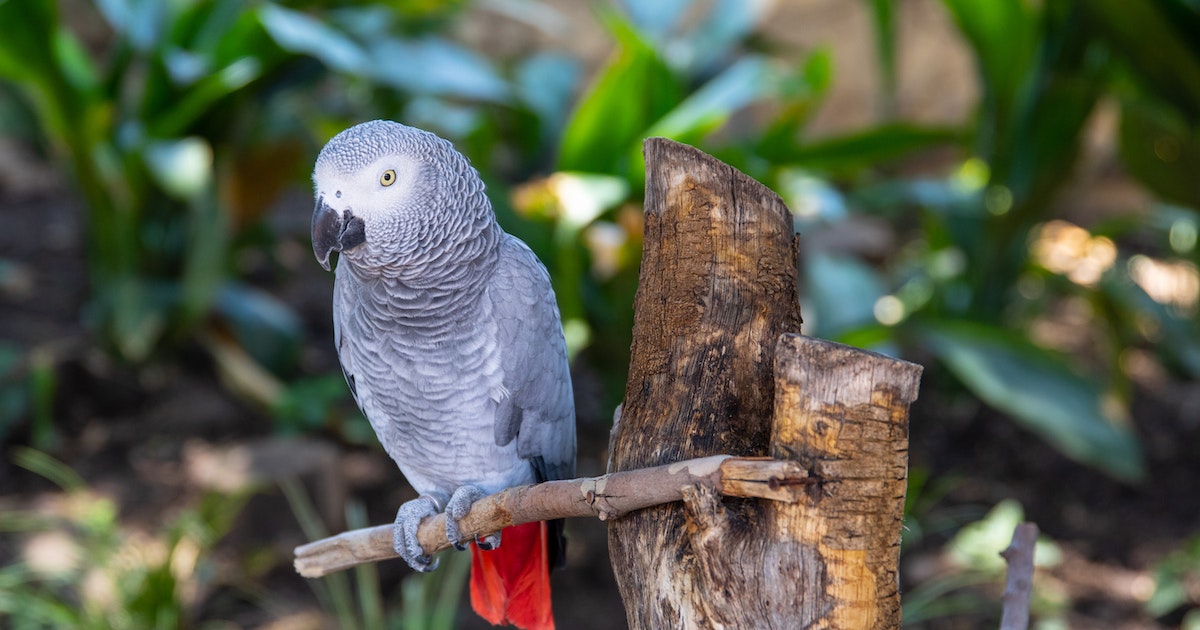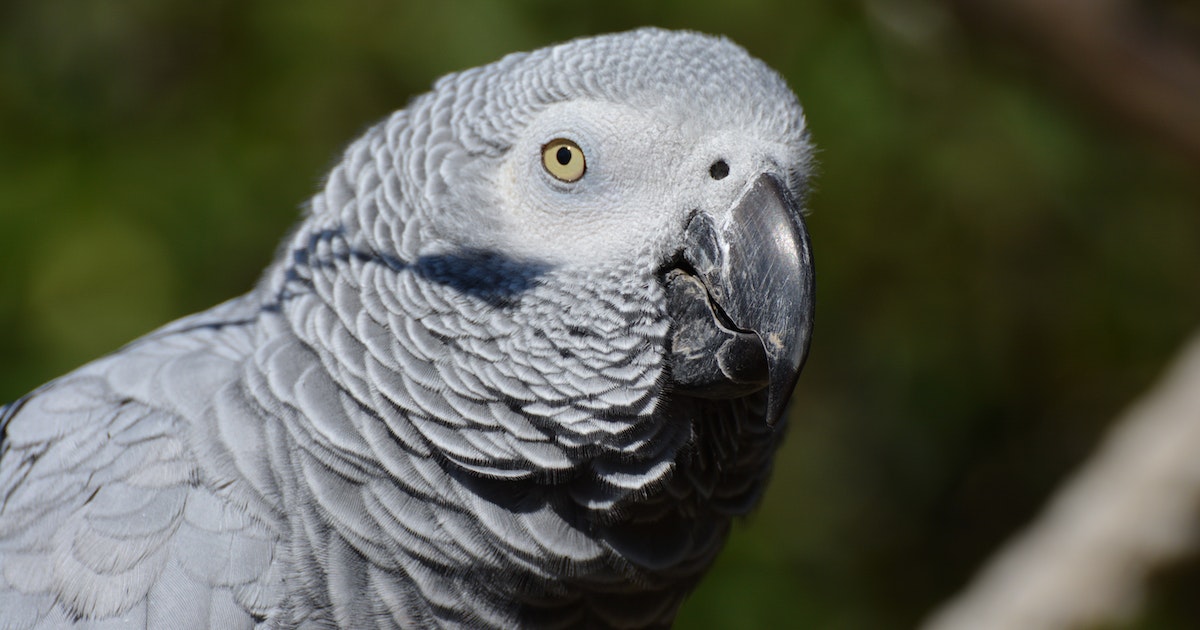African Grey parrots are fascinating avian companions known for their exceptional intelligence and remarkable adaptability. These highly intelligent birds, native to the rainforests of West and Central Africa, have captured the hearts of pet enthusiasts worldwide. However, it’s crucial to understand that training plays a vital role in nurturing their mental stimulation and overall well-being, making it an essential aspect of their care.
Understanding African Grey Parrot Behavior
A. Natural Behavior and Instincts of African Grey Parrots
African Grey parrots have distinct natural behaviors and instincts that are important to comprehend as their caretaker. These parrots are highly social creatures in the wild, living in flocks and engaging in various activities such as foraging, flying, and vocalizing. They exhibit strong cognitive abilities and demonstrate problem-solving skills in their natural habitat.
Understanding their natural behavior helps create an environment that promotes their well-being. It’s important to provide ample mental and physical stimulation, social interaction, and opportunities for exploration.
B. Importance of Understanding Body Language and Vocalizations
Decoding the body language and vocalizations of African Grey parrots is crucial for effective communication and building a strong bond. These parrots utilize a range of non-verbal cues, such as feather position, eye dilation, wing flapping, and head movements, to express their emotions and intentions.
By observing and interpreting their body language, caretakers can better understand when a parrot is happy, stressed, or in need of attention. Similarly, African Grey parrots are renowned for their impressive vocal abilities, including mimicry of human speech and various environmental sounds. Recognizing and responding to their vocalizations aids in addressing their needs and promoting a positive environment.
C. Addressing Common Behavioral Challenges and Their Potential Causes
Like any companion animal, African Grey parrots may face behavioral challenges that require attention and understanding. These challenges can include excessive screaming, biting, feather plucking, or territorial behavior. It’s important to identify the underlying causes, which may include stress, boredom, lack of social interaction, or a need for mental stimulation.
By addressing the root causes of these behavioral challenges, caretakers can implement appropriate training techniques, environmental enrichment, and socialization strategies to alleviate the issues and promote positive behaviors in African Grey parrots.
Do African Grey parrots bite?
Yes, African Grey parrots have the potential to bite. Biting behavior in parrots, including African Grey parrots, can have various underlying reasons, such as fear, territoriality, stress, hormonal changes, or lack of socialization. It’s important to understand that biting is a form of communication for parrots and is often a result of their natural instincts or a response to certain stimuli.
To minimize the likelihood of biting, it is crucial to provide proper socialization, positive reinforcement training, and a stimulating environment for your African Grey parrot. Additionally, respecting your parrot’s body language, providing adequate mental and physical stimulation, and avoiding situations that may trigger fear or stress can help reduce the chances of biting incidents.
If you are experiencing issues with biting behavior, it is recommended to consult with an avian behaviorist or an experienced parrot trainer who can provide guidance and develop a tailored plan to address the underlying causes of the biting behavior. They can help you understand your African Grey parrot’s needs better and work towards fostering a harmonious and trusting relationship.
Positive Reinforcement Training Techniques

A. The Concept of Positive Reinforcement and Its Effectiveness in Training African Grey Parrots
Positive reinforcement is a powerful training technique that focuses on rewarding desired behaviors rather than punishing unwanted behaviors. This approach is highly effective in training African Grey parrots due to their intelligence and ability to associate actions with consequences.
By using positive reinforcement, you can create a positive and enjoyable training experience for your African Grey parrot. This technique builds trust and strengthens the bond between you and your feathered companion, leading to quicker and more successful training outcomes.
B. Step-by-Step Instructions for Using Rewards to Reinforce Desired Behaviors
1. Identify the desired behavior: Determine the specific behavior you want to reinforce, such as stepping onto a perch or speaking a particular word.
2. Choose appropriate rewards: Select enticing rewards that motivate your African Grey parrot, such as small and healthy treats or verbal praise.
3. Timing is key: Deliver the reward immediately after your parrot exhibits the desired behavior. This instant association helps reinforce the connection between the behavior and the reward.
4. Use clear cues: Pair verbal cues or hand signals with the desired behavior to help your parrot understand what is expected. For example, say “Step up” while offering your hand for the parrot to step onto.
5. Repeat and be consistent: Practice the training sessions regularly, repeating the process and reinforcing the behavior consistently. This repetition helps solidify the learning process for your African Grey parrot.
C. Tips for Timing and Consistency in Training Sessions
– Keep training sessions short: African Grey parrots have limited attention spans, so aim for sessions of 10-15 minutes at a time to maintain their engagement and focus.
– Be patient and persistent: Training takes time and consistency. Stay patient and avoid getting frustrated if progress is slow. Each parrot learns at its own pace.
– End on a positive note: Always conclude training sessions with a successful behavior and reward to leave your parrot with a positive association and eagerness for future sessions.
– Create a calm and distraction-free environment: Minimize distractions during training sessions to help your African Grey parrot concentrate and better understand the desired behavior.
Basic Training Commands
A. Essential Basic Commands for African Grey Parrots
Basic commands are the foundation of training for African Grey parrots. They enable effective communication and ensure the parrot’s safety and cooperation. Some essential basic commands include “step up,” “stay,” and “come.” These commands establish control and encourage positive behaviors in everyday interactions.
B. Detailed Training Instructions for Each Command
1. “Step Up”
– Step 1: Approach your African Grey parrot with a perch or your hand and say “Step up” in a clear and gentle tone.
– Step 2: Gently press your finger or the perch against the parrot’s lower chest, just above its feet, encouraging it to step onto your hand or the perch.
– Step 3: As soon as your parrot steps up, reward it with praise or a small treat. Repeat this process consistently to reinforce the association between the command and the desired behavior.
2. “Stay”
– Step 1: Ask your African Grey parrot to “Step up” onto your hand or a perch.
– Step 2: While holding your parrot securely, say “Stay” in a calm and firm voice.
– Step 3: Maintain eye contact and wait for a few seconds before providing positive reinforcement and releasing your parrot. Gradually increase the duration of the “stay” command over time.
3. “Come”
– Step 1: Stand a short distance away from your African Grey parrot and call its name or use a distinct whistle sound to get its attention.
– Step 2: Open your arms or extend your hand while saying “Come” in an inviting tone.
– Step 3: When your parrot approaches you, reward it with praise, a treat, or a favorite toy. Repeat this exercise frequently to reinforce the “come” command.
Visual aids or videos demonstrating these training commands can be highly beneficial in understanding the proper techniques. They provide a visual reference and assist in reinforcing the training concepts.
C. Importance of Patience, Repetition, and Positive Reinforcement
Patience is essential during the training process with African Grey parrots. Each bird learns at its own pace, and it’s crucial to remain calm and consistent throughout the training sessions. Repetition helps reinforce the desired behaviors and ensures that the parrot associates the commands with the correct actions. Positive reinforcement, such as praise, treats, or favorite toys, motivates and rewards the parrot for following the commands, making the training experience enjoyable and effective.
Advanced Training and Enrichment
A. More Advanced Training Exercises for African Grey Parrots
Once your African Grey parrot has mastered the basic commands, you can introduce more advanced training exercises to stimulate their intelligence and further strengthen the bond between you. Some examples of advanced training exercises include target training, recall training, and interactive games.
– Target training: Teach your parrot to touch a target stick or a specific object with its beak or feet. This exercise helps improve focus, coordination, and cognitive skills.
– Recall training: Train your parrot to come to you from a distance when called. Start with short distances and gradually increase the difficulty. Recall training enhances their responsiveness and strengthens the bond between you and your parrot.
– Interactive games: Engage your parrot in games that require problem-solving and interaction, such as puzzle toys or foraging games. These activities provide mental stimulation, prevent boredom, and encourage natural behaviors.
B. Expanding Vocabulary through Word Association and Mimicry Training
African Grey parrots are known for their exceptional mimicry skills and ability to learn words and phrases. You can expand their vocabulary through word association and mimicry training.
– Word association: Repeat specific words or phrases consistently while performing associated actions or providing visual cues. For example, say “hello” when greeting your parrot or “step up” when offering your hand.
– Mimicry training: Create an environment with positive reinforcement where your parrot can imitate words and sounds. Start by speaking clearly and slowly, enunciating the desired words or sounds. Repeat the phrases frequently, and reward your parrot when it attempts to mimic the sounds.
C. Benefits of Incorporating Mental and Physical Enrichment Activities
Incorporating mental and physical enrichment activities into your African Grey parrot’s daily routine is crucial for their overall well-being and happiness.
– Mental enrichment: Engage your parrot in activities that stimulate their cognitive abilities, such as puzzle toys, interactive games, or teaching them new tricks. Mental stimulation keeps their minds active and helps prevent boredom and destructive behaviors.
– Physical enrichment: Provide opportunities for physical exercise and exploration, such as supervised flight or playtime outside of the cage. Physical activity helps maintain their physical health, strengthens muscles, and promotes a sense of freedom.
By incorporating both mental and physical enrichment activities, you can ensure that your African Grey parrot remains intellectually engaged, physically active, and emotionally fulfilled.
Troubleshooting Common Training Challenges
A. Addressing Common Difficulties or Setbacks
During the training process with African Grey parrots, it’s common to encounter difficulties or setbacks. Understanding and addressing these challenges is essential for successful training outcomes.
– Lack of progress: If your parrot seems to be struggling or not making progress, take a step back and evaluate the training approach. Assess if the training sessions are too long, if the rewards are motivating enough, or if the commands are clear. Adjustments may be needed to better suit your parrot’s individual needs.
– Inconsistency: Inconsistency in training can confuse your parrot and hinder progress. Ensure that all family members or caregivers follow the same training techniques and use consistent cues and rewards. Consistency provides clarity and reinforces the desired behaviors.
B. Troubleshooting Tips for Specific Training Issues
– Stubbornness: If your parrot displays stubbornness or refuses to cooperate, it may indicate a lack of motivation or understanding. Evaluate the rewards you’re using and consider if they are enticing enough. You may need to modify the training approach or find alternative rewards that better motivate your parrot.
– Distractions: African Grey parrots are easily distracted, which can disrupt training sessions. Minimize distractions by conducting training in a quiet and calm environment, away from loud noises or other pets. Gradually introduce distractions once your parrot has mastered the commands in a controlled setting.
– Fear-based behaviors: If your parrot displays fear-based behaviors during training, it’s important to proceed with patience and gentleness. Gradually desensitize your parrot to the fear-inducing stimuli by introducing them at a distance and rewarding calm behaviors. Seek professional help or consult an avian behaviorist experienced in positive reinforcement training if the fear-based behaviors persist or worsen.
C. Seeking Professional Help or Consulting Avian Behaviorists
If you’re facing persistent challenges or encountering severe behavioral issues with your African Grey parrot, it’s advisable to seek professional help. Avian behaviorists or experienced trainers specialized in parrot behavior can provide valuable guidance, individualized training plans, and hands-on assistance. They can assess your parrot’s specific needs and tailor training strategies accordingly, ensuring the best possible outcomes for both you and your parrot.
Building a Strong Bond through Training
A. Positive Impact of Training on the Bond between Owners and African Grey Parrots
Training plays a crucial role in building a strong and meaningful bond between owners and African Grey parrots. The positive impact of training goes beyond teaching commands and tricks. It fosters trust, communication, and mutual understanding between you and your parrot.
Through training, you establish a foundation of positive reinforcement, where your parrot learns to associate your presence and interactions with enjoyable experiences. This positive association strengthens the bond, creating a sense of security and companionship.
B. Benefits of Regular Training Sessions for Mutual Trust and Understanding
Regular training sessions with your African Grey parrot offer numerous benefits for mutual trust and understanding:
– Communication: Training provides a structured means of communication between you and your parrot. As you both learn to understand each other’s cues and signals, the lines of communication become clearer and more effective.
– Trust: Training sessions based on positive reinforcement build trust between you and your parrot. When your parrot realizes that following commands leads to rewards and praise, it learns to trust your guidance and willingly participate in the training process.
– Understanding: Through training, you gain a deeper understanding of your parrot’s behavior, preferences, and learning style. This knowledge allows you to tailor the training methods to suit their individual needs, resulting in more effective and efficient training outcomes.
C. Enjoying the Training Process as a Way to Strengthen the Relationship
Training sessions should be enjoyable and fun for both you and your African Grey parrot. Embrace the training process as an opportunity to strengthen your relationship and create lasting memories together.
– Patience and Positivity: Approach each training session with patience and a positive attitude. Celebrate even the smallest achievements and progress. Your enthusiasm and encouragement will make the experience enjoyable for your parrot.
– Bonding Time: View training sessions as dedicated bonding time with your parrot. Engage in playful interactions, incorporate affectionate gestures, and maintain eye contact to enhance the emotional connection between you and your feathered companion.
– Celebrate Progress: Recognize and celebrate the progress you and your parrot make together. Milestones achieved through training strengthen the bond and provide a sense of accomplishment for both of you.
By enjoying the training process and viewing it as a way to strengthen your relationship, you create a positive and enriching experience that enhances the bond between you and your African Grey parrot.
FAQs
1. How long does it take to train an African Grey parrot?
The duration of training for an African Grey parrot can vary depending on several factors, including the individual parrot’s temperament, previous training experience, and the consistency of training sessions. It’s important to remember that training is an ongoing process that requires patience and consistency. Simple commands and behaviors can be taught within a few weeks, but advanced training and building a strong bond may take several months or longer.
2. Can African Grey parrots learn to talk?
Yes, African Grey parrots are renowned for their exceptional mimicry skills and ability to learn words and phrases. With proper training and consistent reinforcement, they can develop an extensive vocabulary. It’s important to note that not all African Grey parrots will talk, as individual abilities may vary. Additionally, some parrots may have preferences for certain words or phrases, and it’s essential to respect their individual learning style.
3. What should I do if my African Grey parrot shows fear or aggression during training?
If your African Grey parrot displays fear or aggression during training, it’s important to proceed with caution and prioritize their emotional well-being. Create a safe and comfortable training environment, gradually introduce new stimuli, and use positive reinforcement techniques to build trust. If the fear or aggression persists or worsens, seek guidance from a professional avian behaviorist who can provide specific strategies to address these behavioral challenges.
4. How often should I conduct training sessions with my African Grey parrot?
Consistency is key when it comes to training African Grey parrots. It’s recommended to conduct training sessions on a daily basis, preferably at a scheduled time when your parrot is alert and receptive. Keep the training sessions short and engaging, focusing on positive reinforcement and rewarding desired behaviors. Remember to adjust the duration and intensity of training based on your parrot’s individual needs and energy levels.
5. Can I train my African Grey parrot to perform tricks?
Yes, African Grey parrots can be trained to perform various tricks and behaviors through positive reinforcement training techniques. Begin with basic commands such as “step up” or “turn around,” and gradually progress to more advanced tricks based on your parrot’s abilities and interests. Always ensure that the training sessions are enjoyable for your parrot, and provide plenty of rewards and praise for their efforts. Training tricks not only stimulates their intelligence but also strengthens the bond between you and your parrot.

Bird Enthusiast
Masters in Counseling & Data Sciences
University of Maryland
Professional Parrots, Pigeons Breeder and Keeper









